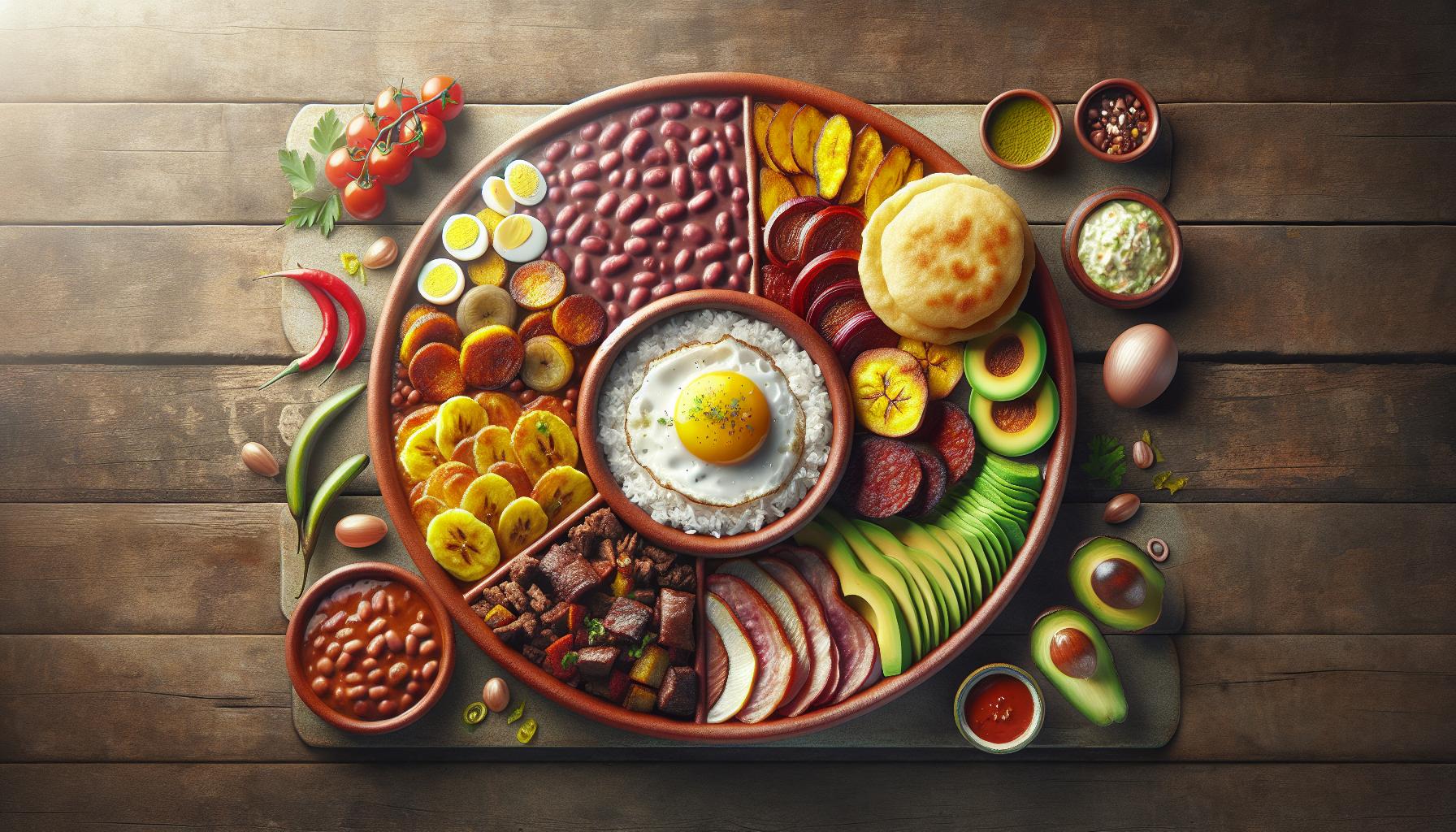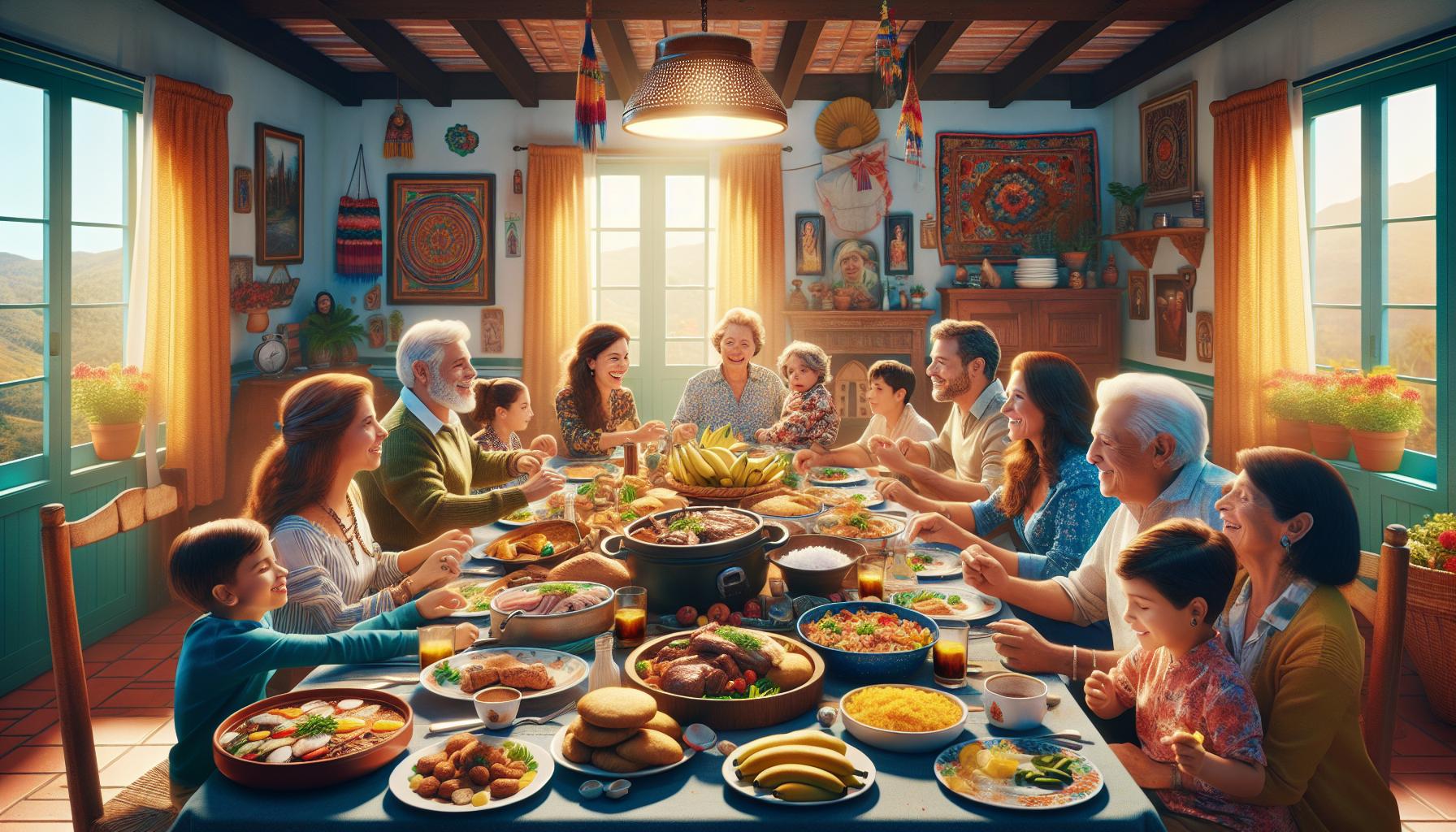Colombian food culture stands as a vibrant tapestry of flavors woven from indigenous traditions African influences and Spanish colonial heritage. From the coastal regions’ fresh seafood to the Andean mountains’ hearty stews this South American nation’s food culture reflects its diverse geography and rich history.
Colombian Food Culture
Colombian food culture represents centuries of cultural fusion, blending indigenous cooking methods with European ingredients and African culinary traditions.
Indigenous and Colonial Influences
Pre-Colombian indigenous peoples contributed staple ingredients like corn, cassava and potatoes to Colombia’s culinary foundation. The Muisca people established farming techniques for quinoa cultivation while the Tayrona introduced tropical fruits like guava and soursop. Spanish colonizers brought cattle, pigs and chickens in the 16th century, along with ingredients like rice, wheat and olive oil. African enslaved people introduced cooking techniques for frying foods and incorporated ingredients like plantains and coconut. This cultural convergence created iconic dishes like arepas, sancocho and bandeja paisa.
Regional Diversity in Colombian Food
Each Colombian region features distinct culinary traditions shaped by local geography and climate. The Caribbean coast specializes in seafood dishes like cazuela de mariscos and arroz con coco. Andean regions favor hearty meat dishes such as ajiaco santafereño and fritanga. The Pacific coast incorporates African influences in dishes like pescado enmallado and arroz con mariscos. The Amazon region utilizes indigenous ingredients like yuca and exotic fruits in traditional preparations. The Eastern Plains feature meat-heavy dishes like ternera a la llanera and hayaca. This regional diversity reflects Colombia’s varied landscapes from tropical coastlines to mountain valleys.
Traditional Colombian Dishes

Colombian food culture features iconic dishes that reflect the country’s diverse cultural heritage through a combination of indigenous ingredients European cooking methods.
Bandeja Paisa: Colombia’s National Dish
Bandeja Paisa represents Colombia’s most renowned dish, originating from the Antioquia region. This hearty platter combines red beans cooked with pork, white rice, ground beef, chicharrón (fried pork belly), fried egg, plantain, chorizo, arepa, avocado, hogao sauce. The dish emerged from the paisa culture’s agricultural roots, providing sustenance for workers in Colombia’s coffee-growing regions. Local restaurants serve variations of this protein-rich meal, with some modern interpretations offering smaller portions while maintaining the traditional components.
Arepas and Their Cultural Significance
Arepas stand as Colombia’s quintessential corn-based flatbread, consumed daily across the country. These round patties come in numerous regional varieties, including arepa de huevo from the Caribbean coast filled with egg, arepa de choclo made with fresh corn, arepa de queso stuffed with cheese. Colombian families prepare arepas for breakfast, paired with butter butter cheese or eggs. Street vendors sell creative versions topped with ingredients like shredded beef, chicken avocado. The preparation method involves grinding corn into masa, shaping it into discs cooking them on a griddle until golden brown.
Colombian Cooking Methods and Ingredients

Colombian food culture relies heavily on traditional cooking techniques passed down through generations, incorporating fresh ingredients from local sources. The preparation methods combine indigenous practices with Spanish colonial influences to create distinctive flavors.
Farm-to-Table Traditions
Colombian farm-to-table practices center on local markets called “plazas de mercado” where farmers sell fresh produce directly to consumers. Small-scale farmers cultivate crops using traditional methods in diverse climate zones, from tropical lowlands to high-altitude páramos. Local food systems support regional specialties: coastal farmers focus on coconuts, plantains, and seafood while Andean regions produce potatoes, corn, and beans. Farmers preserve traditional seed varieties, ensuring the continuation of indigenous crop diversity. Community-based farming collectives maintain ancestral agricultural practices like terrace farming and crop rotation, contributing to sustainable food production.
- Cilantro adds freshness to soups, stews and hogao sauce
- Guascas gives ajiaco soup its distinctive taste
- Oregano flavors meat dishes and bean preparations
- Bay leaves enhance sancocho and bean dishes
- Cumin seasons meat marinades and stews
- Annatto (achiote) provides color and subtle flavor to rice dishes
- Thyme complements potato-based dishes and meat preparations
- Garlic and onions form the base of most Colombian dishes
- Green onions garnish soups and traditional preparations
- Paprika adds mild heat and color to meat dishes
Dining Customs and Etiquette

Colombian dining customs emphasize respect, family bonds and social connections through shared meals. Proper etiquette combines indigenous hospitality traditions with Spanish colonial influences.
Family Gatherings and Social Bonds
Family meals in Colombia serve as central gatherings that strengthen relationships across generations. Hosts welcome guests with coffee or aguapanela upon arrival, setting a warm atmosphere for socializing. Extended family members gather regularly for Sunday lunches featuring multiple courses served family-style. Dining tables accommodate grandparents, parents, children, aunts, uncles and cousins who share stories while passing traditional dishes. The sobremesa tradition encourages lingering at the table after meals for conversation and digestifs like aguardiente. Special occasions like birthdays, holidays and celebrations center around elaborate home-cooked feasts that can last several hours.
Traditional Meal Times
Colombian meal schedules follow distinct patterns throughout the day. Breakfast typically occurs between 6:00-8:00 AM, featuring hearty dishes like calentado or arepas with eggs. Almuerzo (lunch) represents the main meal, served from 12:00-2:00 PM with multiple courses including soup, a protein dish and sides. Many businesses close during lunch hours to allow employees to return home for family meals. La once, a light afternoon snack of coffee and bread, bridges the gap between lunch and dinner. Dinner takes place between 7:00-9:00 PM, consisting of lighter fare like arepas, empanadas or leftovers from lunch.
Street Food Culture
Colombian street food represents the intersection of affordability, convenience, and authentic local flavors. Street vendors operate from dedicated food carts, market stalls, and sidewalk stations across cities and towns.
Popular Street Snacks and Vendors
Street vendors in Colombia offer arepas de queso filled with melted cheese and topped with butter. Empanadas dominate the street food scene, featuring crispy corn flour shells stuffed with meat, potatoes, rice. Fresh fruit vendors sell tropical delights like mango biche, a green mango seasoned with lime juice and salt. Buñuelos, deep-fried cheese dough balls, appear at street corners during morning hours. Obleas con arequipe consist of thin wafers sandwiched with caramel, cheese, or fruit preserves. Lechona vendors serve portions of whole roasted pig stuffed with rice, peas, spices from glass-fronted carts. Churros filled with dulce de leche or arequipe remain popular after-school snacks. Mazorca desgranada stands offer corn kernels topped with cheese, butter, salt.
| Popular Street Food | Common Price Range (COP) | Peak Serving Time |
|---|---|---|
| Arepas de queso | 2,000-4,000 | 6 AM – 10 AM |
| Empanadas | 1,500-3,000 | All day |
| Buñuelos | 1,000-2,500 | 6 AM – 11 AM |
| Lechona (portion) | 8,000-15,000 | 11 AM – 3 PM |
| Churros | 2,000-5,000 | 3 PM – 8 PM |
Colombian Beverages and Coffee Culture
Colombian beverages reflect the country’s biodiversity and cultural heritage through an array of traditional drinks. From world-renowned coffee to tropical fruit juices, these beverages play a central role in daily life and social gatherings.
The Art of Colombian Coffee
Colombian coffee stands out globally for its exceptional quality, grown in the mineral-rich volcanic soil of the Andes Mountains. Coffee cultivation thrives in specific regions like Quindío, Caldas, Risaralda (known as the Coffee Triangle) at altitudes between 4,900-6,400 feet. Colombian farmers hand-pick ripe coffee cherries, process them through washing stations, sun-dry the beans on patios, and employ traditional methods passed down through generations.
Small-batch roasters focus on highlighting distinct flavor profiles from each region:
- Huila produces coffee with chocolate notes caramel undertones
- Nariño beans offer bright acidity citrus hints
- Sierra Nevada creates balanced cups with sweet fruit notes
- Tinto (black coffee) served in small cups throughout the day
- Café con leche (coffee with milk) common at breakfast
- Café cerrero (country-style coffee) brewed using cloth filters
Festivals and Food Celebrations
Colombian food festivals celebrate regional culinary traditions throughout the year. The Festival Gastronomico del Pacifico in Cali showcases Pacific coast specialties like seafood cazuela during July. Medellín’s Feria de las Flores features bandeja paisa competitions alongside traditional flower displays each August.
Key food celebrations include:
- Carnaval de Barranquilla incorporates street food vendors selling arepa de huevo fritas in February
- Festival Nacional del Café highlights coffee culture with barista competitions in Calarcá each June
- Festival de la Lechona spotlights whole roasted pig preparations in Tolima during October
- Festival del Dulce presents traditional sweets like cocadas coconut candies in Popayán during Easter
Regional food events connect specific ingredients with cultural heritage:
- Bogotá’s Alimentarte Food Festival pairs modern gastronomy with indigenous ingredients each September
- Festival del Frito celebrates fried street foods like empanadas in Cartagena during January
- Sabor Barranquilla features Caribbean coastal cuisine demonstrations in August
| Festival | Location | Month | Key Food Focus |
|---|---|---|---|
| Carnaval de Barranquilla | Barranquilla | February | Street Food |
| Festival del Frito | Cartagena | January | Fried Foods |
| Festival Nacional del Café | Calarcá | June | Coffee |
| Alimentarte | Bogotá | September | Fusion Cuisine |
These festivals incorporate cooking demonstrations local ingredient markets live music competitions. Food vendors set up temporary stalls to showcase regional specialties passed down through generations. Many celebrations coincide with religious holidays agricultural harvests creating a connection between food cultural traditions.
Modern Colombian Gastronomy
Colombian food culture continues to evolve while maintaining its cultural roots. Contemporary chefs blend traditional techniques with innovative approaches, creating a dynamic culinary landscape that honors heritage while embracing new possibilities.
Contemporary Food Trends
Colombian restaurants incorporate farm-to-table practices with renewed emphasis on indigenous ingredients. Top establishments like Leo in Bogotá showcase native products through innovative preparations, earning international recognition including a spot on The World’s 50 Best Restaurants list. Plant-based alternatives gain popularity in urban centers, with restaurants offering vegetarian versions of traditional dishes like lentil-based tamales. Food delivery apps transform dining habits, connecting consumers to local eateries across major cities including Medellín, Cali, Cartagena, and Bogotá. Digital platforms enable home cooks to share family recipes, preserving traditional methods while reaching broader audiences. Colombian fusion cuisine emerges in upscale dining scenes, combining local ingredients with international techniques. Sustainable dining practices focus on reducing food waste through composting programs and eco-friendly packaging. Food tourism experiences include cooking classes, market tours, and coffee farm visits, attracting culinary enthusiasts from global destinations.
A Vibrant Testament to the Country’s Rich Heritage
Colombian food culture stands as a vibrant testament to the country’s rich heritage and diverse influences. From indigenous roots to Spanish colonial impact and African contributions the cuisine continues to evolve while maintaining its authentic character. The blend of traditional cooking methods modern culinary innovations and deeply rooted social customs creates an unforgettable gastronomic experience.
The future of Colombian cuisine looks promising as chefs and home cooks alike embrace both tradition and innovation. Through festivals street food culture and family gatherings Colombian food remains a powerful force that brings people together and shares the country’s story with the world.



